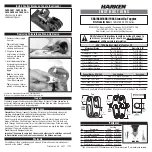
INM 5500 Rev 11
4
3 .1 Modules – pre-installation
3 .1 .1 Switch settings for operating conditions
Some modules have operating conditions, such as Line-Fault Detection (LFD), Phase Reversal,
etc., that can be established by the setting of switches on the unit. The subminiature switches
are accessible through an aperture on the side of the module (see Figure 3.2) and can be set in
the required positions with, for example, the blade of a small screwdriver.
The switch setting options are always indicated on the side label of the module, but the user may
also consult the individual module information in Section 6 of this manual for details.
Figure 3 .2: Location of switches
3 .1 .2 Relay outputs
Reactive loads on all units with relays should be adequately suppressed. To achieve maximum
contact life on all
mechanical
output relays, the load should not be less than 50mW, e.g. 10mA at ≥
5V DC.
3 .1 .3 Ambient temperature considerations
Ambient temperature limits for unenclosed MTL5500 range of isolators are from –20°C to +60°C
with units close-packed and modules with the -T suffix have an extended temperature rating of
+65°C, unless otherwise specified.
3 .2 Installing columns of isolators
On new installations, if isolators are mounted in several rows or columns, mount alternate rows or
columns so that units face in opposite directions. This allows safe- and hazardous-area wiring looms
to be shared. See Figure 3.1 for isolator dimensions.
3 .2 .1 Mounting isolators on DIN rail
Figure 3 .3: DIN rail mounting and removal of isolators
Clip an isolator onto the DIN rail as shown in Figure 3.3, with the blue signal plugs facing
towards the hazardous-area. To remove an isolator from the rail, insert a screwdriver blade
(2.5 - 5.0mm diam.) into the clip as shown. This will release the clip so that the isolator may
be pivoted off the rail - there is no need to lever the clip. Allow a maximum mounting pitch of
16.2mm for each unit.
OFF position
ON position
1 2 3 4
Mounting
Removal













































